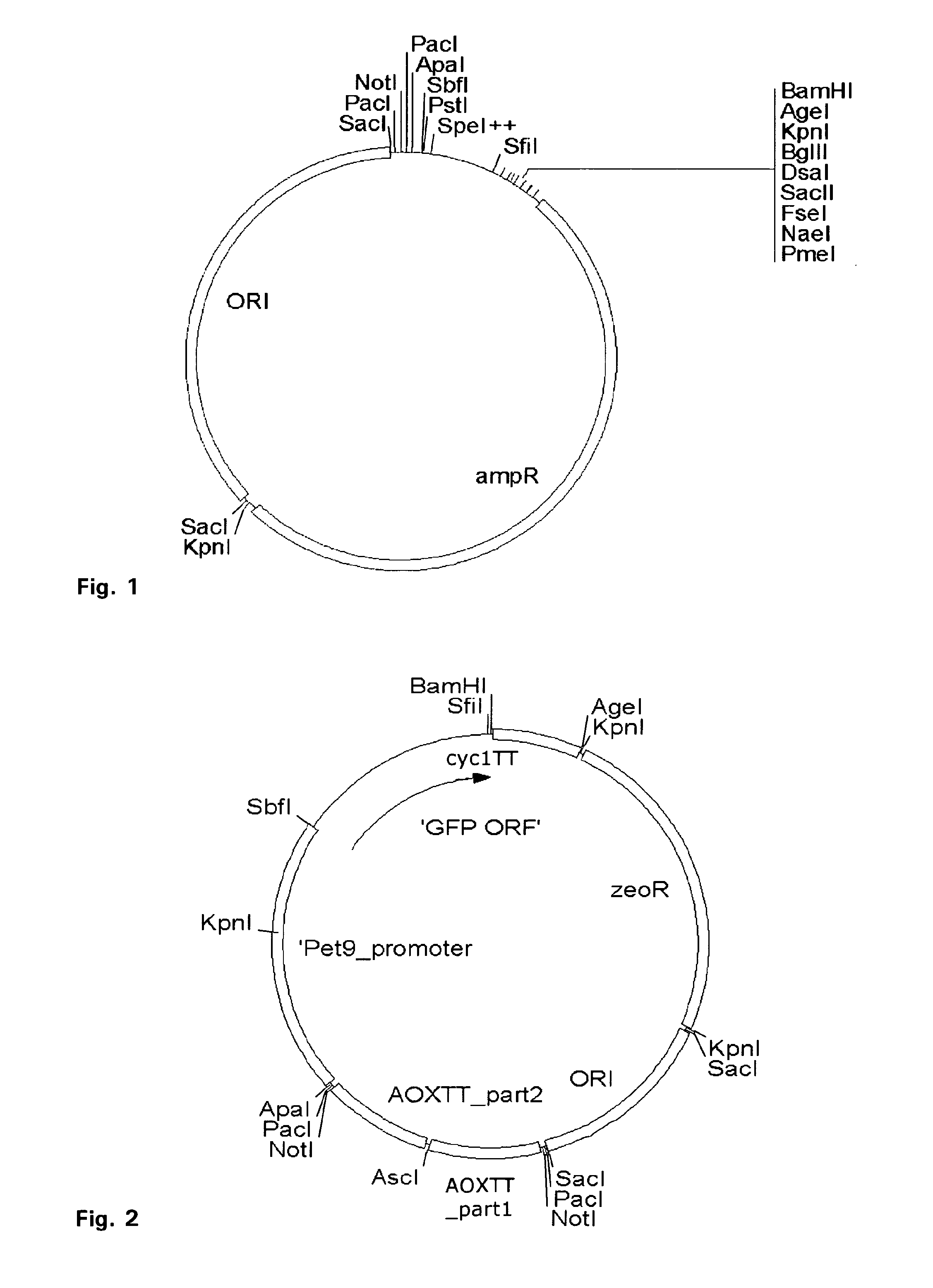Expression system
a technology of expression system and protein, applied in the field of biotechnology, can solve the problems of inability to transfer positive results to other strains, limited by the actual knowledge about the function of such proteins supporting the secretion of other proteins, and the inability to predict the function of helper proteins with the current knowledge, so as to increase the secretion of a protein of interest (poi), and increase the secretion of protein
- Summary
- Abstract
- Description
- Claims
- Application Information
AI Technical Summary
Benefits of technology
Problems solved by technology
Method used
Image
Examples
example 1
Identification and Cloning of Several Secretion Helper Factors from Saccharomyces cerevisiae
[0172]In order to identify genes and their respective proteins which play a potential role during protein production, e.g. in the protein secretory pathway of P. pastoris the gene expression pattern of a P. pastoris strain containing the gene for human trypsinogen 1 was compared before and after induction of heterologous protein production (induction was done by a switch from glycerol to methanol as the sole carbon source), i.e. of trypsinogen production by microarray analysis.
[0173]As the genome sequence of P. pastoris has not been published and not many genes are characterized for P. pastoris DNA microarrays of S. cerevisiae were used for heterologous hybridization with P. pastoris cDNA.
[0174]The experimental procedure of the microarray hybridisation and the evaluation of the obtained data was carried out as described in Sauer et al. (2004). Further details are found below.
[0175]a) Strain:...
example 2
Investigation of the Effect of the Secretion Helper Factors on Heterologous Protein Production of Recombinant 2F5 Fab in P. pastoris
[0209]The plasmid DNA from E. coli from Example 1 was used to transform P. pastoris strain SMD1168 already containing the expression cassettes for 2F5 Fab under control of the GAP promoter, which strain was pre-selected for a high Fab secretion level. The strain SMD1168 is a P. pastoris his4-defective strain (a pep4 mutant). Selection was based on zeocin resistance for the antibody genes, and histidin auxotrophy for the other genes.
[0210]a) Construction of the P. pastoris Strain SMD1168 Secreting the Fab Fragment of the Monoclonal Anti-HIV1 Antibody 2F5:
[0211]2F5 antibody fragment sequences for the Fab light and heavy chain were amplified by PCR from pRC / RSV containing the humanized IgG1 mAb as disclosed in Gasser et al., 2006. The restriction sites EcoRI and SacII were used for cloning.
[0212]In detail, for the generation of Fab, the entire light chain...
example 3
Cloning of the Vector Backbone of pPuzzle
[0227]For construction of the novel vector system pPuzzle a 2884 bp fragment carrying an origin of replication and a selection marker for E. coli (AmpR cassette) was amplified from a common used cloning vector pBR322 (Fermentas Life Science, Germany, #SD0041 pBR322 DNA) by PCR. Two non-template coded NotI restrictions sites were added by using the forward primer pBR322_FOR_NotI and the backward primer pBR322_BACK_NotI. This PCR fragment was used as a shuttle supplying a temporary origin of replication and a selection marker for amplifying an artificial multiple cloning site in E. coli. A 244 bp synthetic DNA fragment (synthesised and subcloned in the EcoRV site of the pUC57 plasmid by GeneScript Corp. Piscataway, N.J. 08854 USA) was cut with NotI and ligated with the NotI and alkaline phosphatase treated shuttle fragment and amplified in E. coli. The resulting product was called pBR322½artMCS. To generate pBR322½artMCS_ORI, a 670 bp fragment ...
PUM
| Property | Measurement | Unit |
|---|---|---|
| volume | aaaaa | aaaaa |
| temperature | aaaaa | aaaaa |
| concentration | aaaaa | aaaaa |
Abstract
Description
Claims
Application Information
 Login to View More
Login to View More - R&D
- Intellectual Property
- Life Sciences
- Materials
- Tech Scout
- Unparalleled Data Quality
- Higher Quality Content
- 60% Fewer Hallucinations
Browse by: Latest US Patents, China's latest patents, Technical Efficacy Thesaurus, Application Domain, Technology Topic, Popular Technical Reports.
© 2025 PatSnap. All rights reserved.Legal|Privacy policy|Modern Slavery Act Transparency Statement|Sitemap|About US| Contact US: help@patsnap.com


